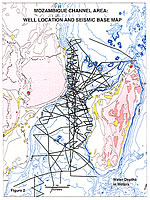The study area, which includes the Mozambique Channel with water depths from 500 to 4000 meters, and the bordering coastal shelves of Madagascar, Mozambique, and southern Tanzania is approximately 1,300,000 sq. kms, an area greater than the North Sea (Figs. 1& 2). This vast area of study comprises 9 basins or sub-basins, each with a unique set of hydrocarbon factors. Although major gas reserves (3.5 TCF) of the Pande-Temane complex in Mozambique, and the Bemolanga tar sands (20 billion barrels) and Tsimiroro oilfield (8 billion barrels) in Madagascar have been known for years, a total of only 23 exploration wells have been drilled offshore.
![]()
Approximately 31,000 kms of seismic profiles have been interpreted and integrated with well, gravity and magnetic data (Fig. 2). The seismic data, which were not available until now, are 1972 to 1989 vintage, multi-channel recordings with Flexotir source. These data can be integrated with the existing seismic control acquired by oil companies on the Mozambique shelf (50,000 kms) and on the Madagascar shelf (40,000 kms). Seismic refraction data, recorded in tandem with reflection data along several profiles provides additional control. Geologic data from approximately 80 onshore and 23 offshore wells in Mozambique, Madagascar and southern Tanzania has been utilized in the interpretation and evaluation process. Research and other archival geologic and geophysical studies provided by OMNIS, ENH, IPCP, EOST, CNRS and Geoscience Azur have been utilized for the project.
![]()
From late Carboniferous to late Triassic - early Jurassic, East Africa was deformed by recurrent rifting, which resulted in Karoo continental deposition. During a post-Karoo early Jurassic transgression, clastic, carbonates and evaporites were deposited along the pre-breakup plate margins. A subsequent marine transgression took place in mid Jurassic with widespread deposition of shelf carbonates and basinal sediments. At this stage, probably Bajocian, the onset of drift occurred. The Madagascar - India - Antartica plate separated from Africa, moving incrementally southward along the Davie Fracture Zone until early Aptian (Fig. 3). During the drift phase, predominantly marine deposition took place throughout the region. The post-drift marginal sag phase, which followed an Aptian hiatus and persisted until the present, resulted in the deposition of thick marine siliciclastics.


